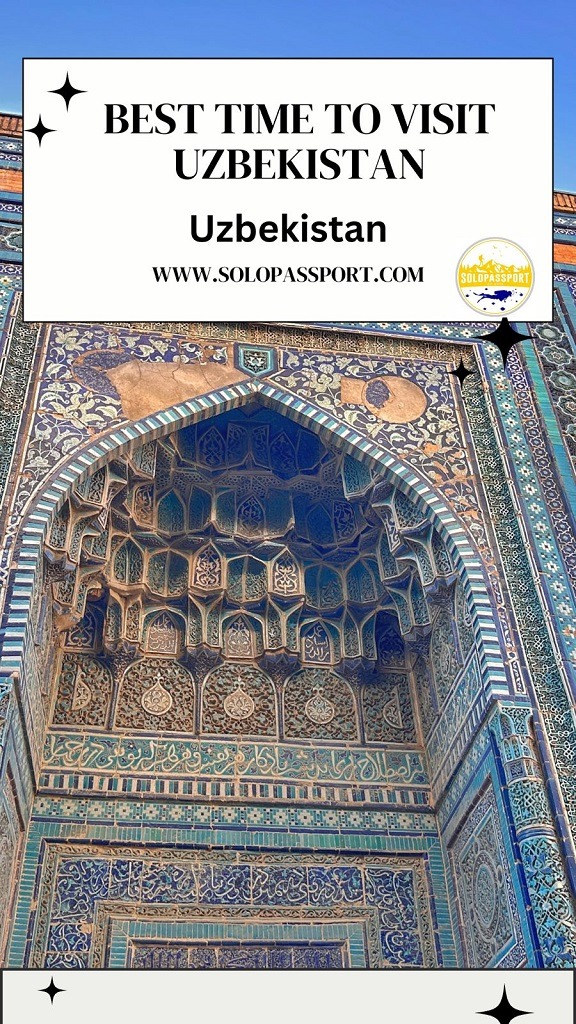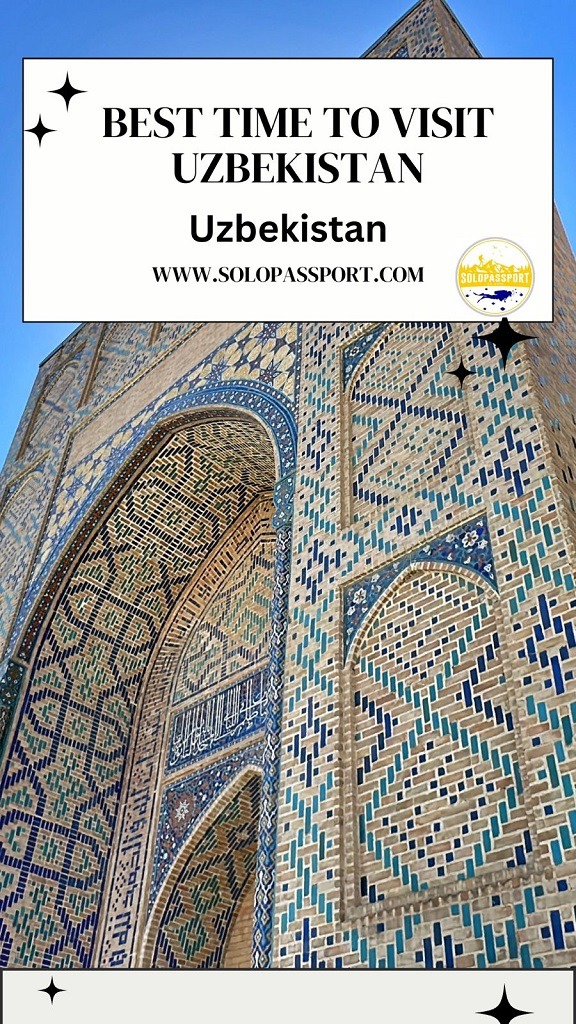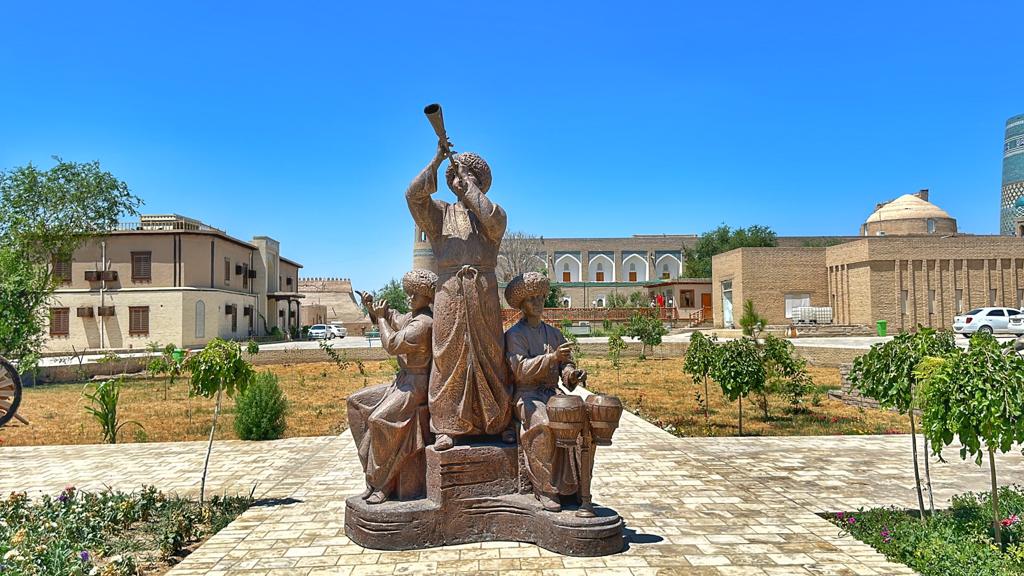Best Time to Visit Uzbekistan: Your Ultimate Travel Guide
Are you wondering when is the best time to visit Uzbekistan? As someone who has explored the country’s historic cities and beautiful landscapes, I understand the importance of timing your trip right.
Uzbekistan has contrasting climates, with hot summers and freezing winters, so choosing the ideal season to travel can make a big difference. This guide will help you determine the best time to explore Uzbekistan based on my experiences travelling through Tashkent, Samarkand, and Khiva.
Uzbekistan offers something unique every season, from vibrant spring festivals to the breathtaking autumn scenery. Due to the mild weather, spring and autumn, particularly April to May and September to October, are the most popular times to visit. These months offer pleasant temperatures and are ideal for sightseeing, exploring ancient Silk Road cities, and enjoying local markets. However, winter might be a good option if you prefer to experience the country with fewer tourists, though it can be quite cold.
Whether you’re planning to wander through the historical wonders of Samarkand or relax in Khiva’s ancient courtyards, this guide will give you all the information you need to decide when to embark on your Uzbekistan adventure.
This article may contain affiliate links, meaning if you decide to purchase via my links, I may earn a commission at no additional cost to you. For complete information, please see our affiliate disclaimer here.
Page Contents
Uzbekistan Travel Resources
For Best Hotels in Uzbekistan, use Booking.com
For Hostels in Uzbekistan, use Hostelworld
Use Skyscanner to get affordable tickets to Uzbekistan
Viator and GetYourGuide are the best tour operators
Rentalcars and Discover Cars are the best agencies to rent out cars at the lowest prices
SafetyWing or WorldNomads for travel insurance
Travel Blogs
Best Time to Visit Uzbekistan
Traversing Through Uzbekistan’s Timeless Gem: Things To Do in Tashkent
Samarkand Travel Guide – The Pearl of the East
What to see in Khiva? Journey through Uzbekistan’s living museum
5 Best Hotels in Tashkent
About Uzbekistan
Uzbekistan is a country rich in history and culture. It is located along the ancient Silk Road in Central Asia and is known for its stunning architecture, bustling markets, and well-preserved historical sites.
Uzbekistan is also famous for its hospitality. Locals often invite tourists for tea or to share meals. Traditional Uzbek cuisine includes dishes like plov (a rice dish with meat and vegetables) and manti (steamed dumplings).
Despite its historical and cultural richness, the country remains relatively off the beaten path for many tourists, making it a fascinating destination for those exploring lesser-known regions. With easy access from India, Uzbekistan is an excellent choice for travellers seeking a blend of history, culture, and adventure.
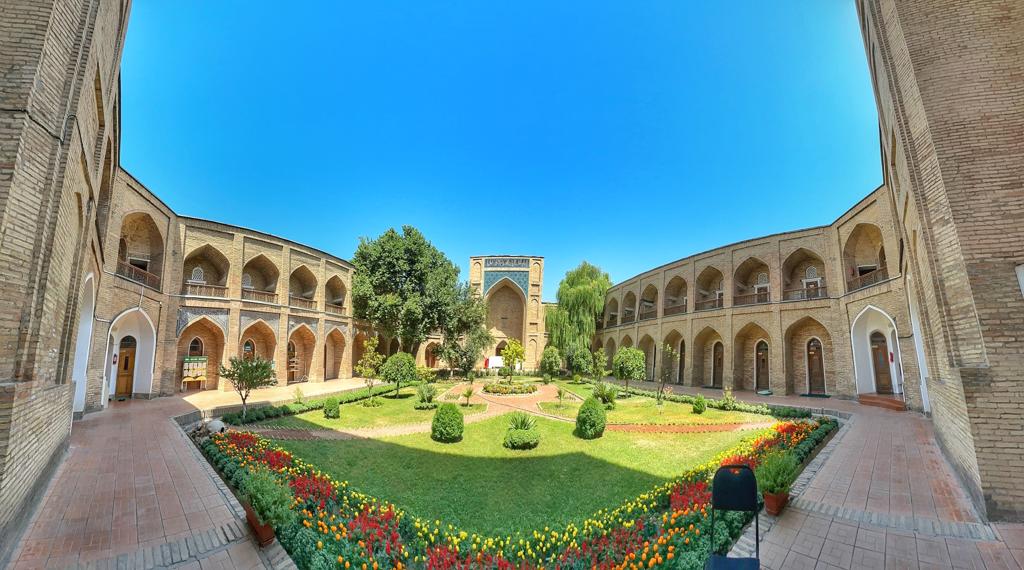
Tashkent, the capital city, blends Soviet-era buildings and modern developments, offering museums, mosques, and vibrant bazaars.
Khiva, a UNESCO World Heritage Site, is like an open-air museum with its ancient walled city, Itchan Kala. Its beautifully preserved palaces, minarets, and madrassas offer a glimpse into medieval Islamic architecture.
Samarkand is perhaps the most famous city in Uzbekistan. It is known for its Registan Square, surrounded by majestic madrasas with intricate tilework. Samarkand is also home to the stunning Gur-e-Amir Mausoleum and the grand Bibi-Khanym Mosque. The city has been an important centre of culture and trade for centuries, drawing travellers for its historical significance and architectural wonders.
History of Uzbekistan
Uzbekistan’s history is deeply intertwined with the ancient Silk Road, the trade route that connected the East and West for centuries. Its cities, such as Samarkand, Bukhara, and Khiva, were vital trading and cultural hubs along this route. These cities flourished, attracting scholars, artisans, and traders from various regions. Uzbekistan’s historical roots go back to ancient civilizations, with early settlements dating back to the 1st millennium BC.
In the 4th century BC, Alexander the Great conquered the region, leaving behind Greek cultural influences. The area was later ruled by various empires, including the Persian Sassanids and the Arab Caliphate, which introduced Islam in the 7th century. The region’s golden age came during the 14th and 15th centuries under the rule of Timur (Tamerlane), who established Samarkand as the capital of his empire. Timur’s reign marked an architectural and cultural prosperity era, with Samarkand becoming a centre of learning and art.
In the 19th century, Uzbekistan fell under Russian control and became part of the Soviet Union in 1924. After gaining independence from the Soviet Union in 1991, Uzbekistan became a sovereign nation. Today, Uzbekistan’s rich history is reflected in its UNESCO World Heritage Sites, ancient cities, and cultural traditions that have endured centuries of change. It remains a crossroads of civilizations, where the legacy of its past is visible in its architecture, art, and traditions.
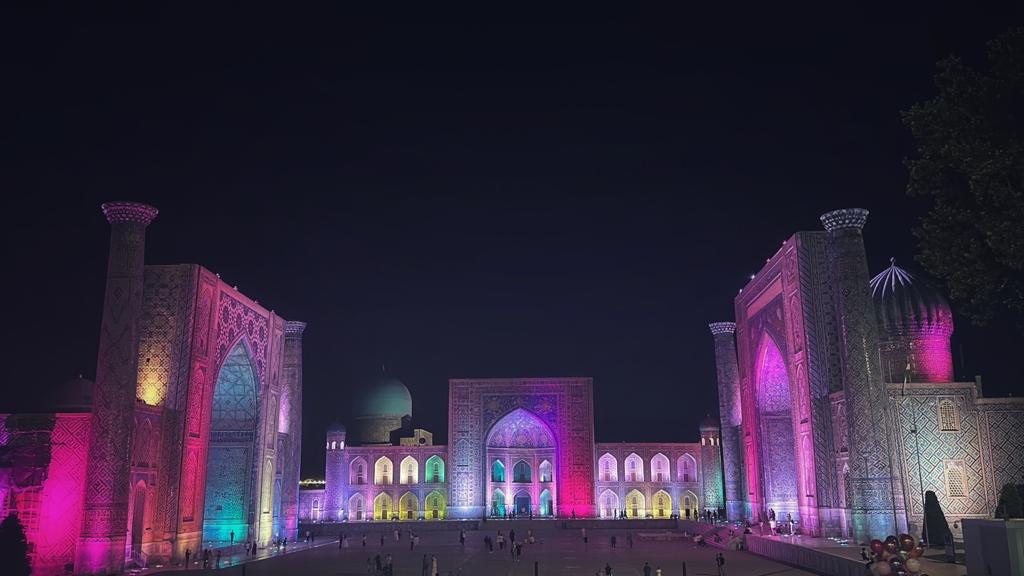
Best Time to Visit Uzbekistan
The best times to visit Uzbekistan are spring (April to June) and autumn (September to November). These seasons offer pleasant weather, ideal for sightseeing and exploring the country’s historical sites.
In spring, Uzbekistan comes alive with blooming flowers and mild temperatures, typically between 15°C and 25°C. This is a great time to visit cities like Samarkand, Bukhara, and Khiva, where you can comfortably explore the famous Silk Road architecture without the intense summer heat.
Autumn is another excellent time to visit, with temperatures between 20°C and 30°C. The weather is warm but not too hot, and the landscapes are vibrant as the summer crops are harvested. This is also the season for fresh fruits like pomegranates and melons, adding a delightful culinary experience to your trip.
Summer (July and August) can be extremely hot, with temperatures often exceeding 40°C, especially in desert regions. I visited Uzbekistan in July for my birthday, which was a challenging experience. The temperatures were extremely high, especially during train journeys, making travel uncomfortable. The heat in the desert areas was intense, and I found it difficult to enjoy the trip under such harsh conditions.
Winters (December to February) are cold, particularly in the northern parts, with temperatures dropping below freezing. However, if you’re looking for fewer crowds and a quieter experience, winter can still be a suitable time to visit, especially in Tashkent.
How to Get to Uzbekistan?
Getting to Uzbekistan by air is convenient, with direct and connecting flights from various international cities. Tashkent International Airport (TAS), located in the capital city, Tashkent, is the main gateway for international travellers. It is well-connected to major cities in Europe, Asia, and the Middle East.
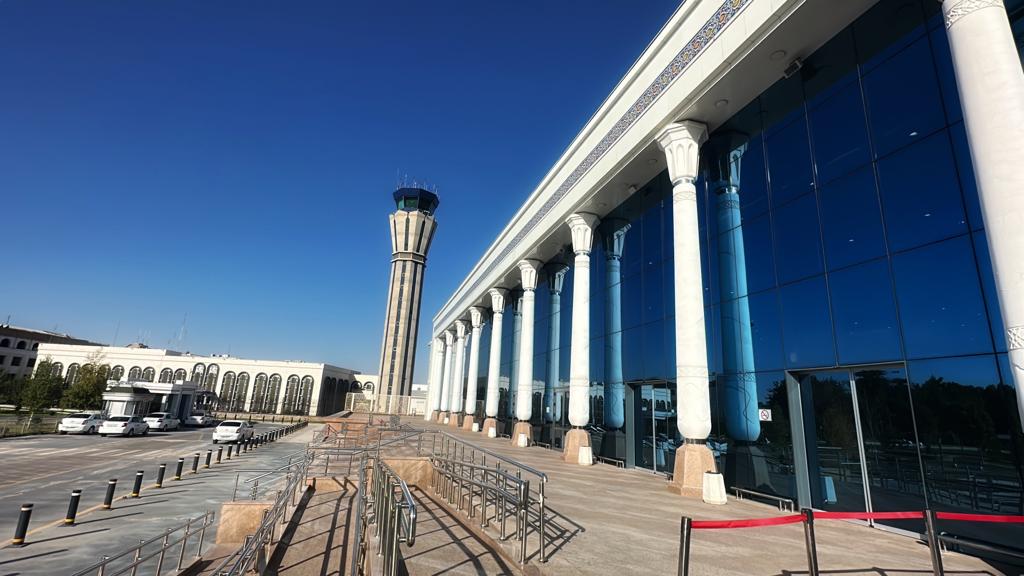
Direct Flights
- From India: Uzbekistan Airways offers direct flights from Delhi to Tashkent, which take around 3.5 hours.
- From Australia: There are no direct flights from Australia to Uzbekistan. However, travellers can connect via major hubs like Dubai, Doha, or Istanbul.
- From Europe: Several European cities, such as London, Paris, Frankfurt, and Moscow, offer direct flights to Tashkent, operated by airlines like Uzbekistan Airways and Aeroflot.
- From the Middle East: Airlines such as Emirates, Flydubai, and Qatar Airways provide direct connections from cities like Dubai and Doha to Tashkent.
Connecting Flights
For cities without direct flights, you can easily reach Uzbekistan by connecting through hubs like Istanbul, Dubai, or Moscow. These hubs frequently fly to Tashkent and other Uzbek cities like Samarkand and Bukhara.
Domestic Airports
In addition to Tashkent, Samarkand, Bukhara, and Urgench (for Khiva) also have airports accessible via domestic flights from Tashkent, allowing for easy travel within the country.
It is advisable to book tickets in advance, especially during the peak travel seasons in spring and autumn, when flights tend to fill up quickly.
Where to Stay in Uzbekistan?
When travelling in Uzbekistan, several accommodation options suit different preferences and budgets.
Tashkent
The capital city offers a range of hotels from luxury to budget.
- For a high-end experience, consider the Hyatt Regency Tashkent or the International Hotel Tashkent, which offers top-notch amenities and central locations.
- Mid-range options include the City Palace Hotel Tashkent and Lotte City Hotels Tashkent Palace, offering comfort and convenience.
- Budget travellers can find guesthouses and hostels like Safarov’s Family Hostel.

Samarkand
Known for its historic charm, Samarkand has a variety of accommodations.
- The Hotel Grand Samarkand is a great choice for luxury, providing elegant rooms and excellent service. I stayed at Zarafshon Parkside Hotel, which was very comfortable and pleasant.
- Mid-range options include the Registan Sultan Hotel and the Antica Guest House.
- Affordable hostels, guesthouses, and B&Bs like the Bibikhanum Hotel offer a more personal experience.
Bukhara
This city features traditional Uzbek-style hotels.
- For a higher-end stay, consider the Devon Begi Heritage Hotel.
- The Amulet Hotel and the Minzifa Inn blend comfort and local character.
- Budget travellers can find cozy hostels and guesthouses like the Zargaron Plaza.
Khiva
- For a unique experience, stay within the ancient city walls at the Arkanchi Hotel or Gold Khiva. These options provide easy access to the historical sites. You can also stay at the Farovon Khiva Hotel, which is very beautiful and comfortable.
- Mid-range choices include the Asia Khiva Hotel.
Tourist/Visitor Visa Requirements for Uzbekistan
For Indian Nationals
Indian nationals travelling to Uzbekistan need a tourist visa to enter the country. However, the country has recently simplified its visa process, making it easier for Indian travellers to visit.
Visa Types
- e-Visa: The easiest option is to apply for an electronic visa (e-Visa) online. It is available for Indian citizens and allows stays of up to 30 days.
- Regular Tourist Visa: If you prefer, you can also apply for a regular tourist visa through the Uzbekistan Embassy or Consulate in India.
e-Visa Process for Indian Nationals
- Online Application: Visit the Uzbekistan e-Visa portal and complete the application form. You must provide personal details, passport information, and travel itinerary.
- Required Documents:
- A valid Indian passport (with at least 6 months validity from arrival).
- A recent passport-sized photograph (as per visa requirements).
- Proof of accommodation or hotel booking.
- Payment for the visa processing fee (approximately USD 20).
- Processing Time: The e-Visa is usually processed within 2 to 3 business days.
- Validity: The e-Visa is valid for 90 days from the date of issue, allowing for a stay of up to 30 days in Uzbekistan.
Visa on Arrival
Uzbekistan does not offer visa-on-arrival facilities for Indian nationals, so ensure you have your visa before you depart.
Important Tips
- Always carry a printed copy of your e-Visa for immigration purposes.
- Ensure your passport has sufficient validity and blank pages for stamping.
For Australian Citizens
Australian citizens travelling to Uzbekistan for short tourist visits do not need a visa. In 2018, the country introduced a visa-free entry policy for Australian passport holders, allowing easier access to the country for tourism.
Visa-Free Entry for Australian Citizens
- Duration: Australians can visit Uzbekistan visa-free for up to 30 days.
- Passport Requirements:
- Your Australian passport must be valid for at least 6 months from your entry date.
- Ensure that your passport has at least one blank page for entry and exit stamps.
- Purpose of Visit: Visa-free access is granted for tourism purposes only. If you plan to stay longer than 30 days or visit for other reasons, such as business or work, you must apply for an appropriate visa.
- Entry Points: You can enter Uzbekistan through major international airports like Tashkent International Airport or land borders.
Important Tips
- When entering Uzbekistan, carry proof of your accommodation bookings, return flight tickets, and travel insurance.
- Register with local authorities within three days of your arrival (your hotel usually handles this for you).
For United States Citizens
Uzbekistan offers visa-free entry for US citizens travelling for tourism, simplifying the process for American travellers.
Visa-Free Entry for US Citizens:
- Duration: US citizens can visit Uzbekistan for up to 30 days without a visa.
- Passport Requirements:
- Your passport must be valid for at least 6 months from your entry date.
- Ensure your passport has at least one blank page for entry and exit stamps.
- Purpose of Visit: Visa-free entry is granted for tourism and short-term visits.
- Entry Points: US citizens can enter Uzbekistan through major international airports such as Tashkent International Airport or via land borders.
Registration Requirement
Upon arrival, you must register with local authorities within three days of entering Uzbekistan. Most hotels take care of this registration on behalf of their guests, but if you’re staying in a private residence, ensure that the host registers your stay at the local office of the Ministry of Internal Affairs.
Important Tips
- Carry a copy of your passport and travel insurance at all times.
- Keep your hotel registration slips, as you might be asked for them upon exiting the country.
Currency, Money Exchange and ATMs
The official currency of Uzbekistan is the Uzbekistani Som (UZS). Notes come in various denominations, ranging from 1,000 to 100,000 Som, with the larger notes being more common in daily transactions. It’s important to carry smaller bills as change can sometimes be hard to come by, especially in smaller towns.

Money exchange is readily available in major cities like Tashkent, Samarkand, and Bukhara. Authorized exchange offices are found at airports, banks, and some hotels. It is advisable to exchange money at official exchange points to avoid scams and counterfeit notes.
US dollars and euros are the most commonly accepted foreign currencies for exchange. Indian rupees or Australian dollars are not accepted for exchange anywhere, so travellers should bring US dollars or euros for easy conversion. Remember to carry newer, undamaged notes, as old or marked bills may not be accepted.
ATMs are available in larger cities, especially tourist areas, but they may not be as common in rural or remote regions. Most ATMs dispense Uzbek som, but some also offer US dollars. Visa and Mastercard are the most widely accepted cards, though acceptance can vary outside major urban centres. It’s a good idea to carry enough cash for rural areas where ATMs may be scarce, and credit cards may not be accepted.
While credit cards are accepted in upscale hotels and restaurants, Uzbekistan is largely a cash-based economy, so having local currency on hand is essential for daily transactions and shopping at bazaars.
Language Spoken in Uzbekistan
The official language of Uzbekistan is Uzbek, a Turkic language spoken by most of the population. It is the primary language used in government, education, and daily life. Uzbek has its roots in the Turkic language family, with many words influenced by Persian, Arabic, and Russian due to the country’s historical connections.
Russian is widely spoken, especially in urban areas like Tashkent and among older generations. While it is not the official language, Russian still plays a significant role in business, government, and media. Many Uzbeks are bilingual in Uzbek and Russian, and Russian is frequently used in signage, public transportation, and official documents.
The English language is a challenge in Uzbekistan. English proficiency is not widespread, and knowing a few basic phrases in Uzbek or Russian can be helpful when travelling through the country.
Uzbekistan SIM Card
In Uzbekistan, getting a local SIM card is straightforward, and travellers are recommended to stay connected. Upon arrival at Tashkent International Airport, you can purchase a SIM card, which is available at kiosks from major telecom providers like Mobiuz, Beeline, and Uztelecom. Buying a SIM at the airport is convenient as the staff is used to assisting tourists, and you can start using local services immediately.
To buy a SIM card, you will need a valid passport for registration, as it is required by law for foreigners. The process is simple and quick, with the staff helping you. Most vendors only accept cash, so ensure you have Uzbek Som ready, especially since Indian rupees or Australian dollars are not accepted.
SIM card packages typically include data, local calls, and text messages, and the prices are generally affordable. You can choose plans based on your data needs, and many providers offer tourist-specific plans with sufficient data for navigation, social media, and calling apps. Remember that 4G coverage is strong in major cities like Tashkent, Samarkand, and Bukhara but might be limited in remote areas.
For added convenience, you can opt for a global eSIM, eliminating the need to buy a local SIM in every country you visit. Airalo is a reliable option for purchasing an eSIM.
Number of Days Required to Explore Uzbekistan
The ideal duration for exploring Uzbekistan depends on how much you want to see, but 7 to 10 days is generally recommended for a well-rounded trip. This timeframe allows visitors to cover the key cities of Tashkent, Samarkand, Bukhara, and Khiva, which offer a rich mix of history, culture, and architecture. I travelled for ten days in Uzbekistan and covered Tashkent, Khiva and Samarkand.
A 7-day trip would give you enough time to explore the highlights. Start with 1-2 days in Tashkent, the capital city, to visit museums, markets, and mosques. Next, head to Samarkand, where you can spend 2-3 days exploring iconic landmarks like Registan Square, Gur-e-Amir Mausoleum, and Shah-i-Zinda. Samarkand is a city full of architectural marvels and history, as seen from the Silk Road.

Bukhara is a four-hour train ride from Samarkand. You can visit its ancient city centre, Ark Fortress, and famous bazaars for two days. Bukhara is smaller and can be explored on foot, offering a more laid-back atmosphere than Samarkand.
If you have ten days, consider adding a 2-day trip to Khiva, a well-preserved medieval town with a completely intact city wall. With its ancient mosques, madrasas, and minarets, Khiva offers a unique experience.
For outdoor activities, a 10-day itinerary can include a trip to the Nuratau Mountains or the Kyzylkum Desert. Overall, 7 to 10 days allows you to see the best of Uzbekistan without feeling rushed.
Travelling within Uzbekistan
Travelling within Uzbekistan is relatively easy, with various options for getting around the country.
The most popular and efficient mode of transportation is the train. Uzbekistan has a well-developed railway network connecting major cities such as Tashkent, Samarkand, Bukhara, and Khiva. The high-speed Afrosiyob trains are modern, comfortable, and fast. However, booking Afrosiyob tickets well in advance is essential as they sell out quickly.
Avoid using old Soviet Union trains. They are often uncomfortable and lack functional air conditioning, making travel hot and frustrating. These trains can also be slow and less pleasant than the newer options.
Buses and shared taxis are alternative options for intercity travel. Buses are cheaper but can be slower and less comfortable, while shared taxis are faster and more convenient for shorter distances. Be sure to negotiate fares for shared taxis before starting the journey.

Within cities, taxis are widely available and affordable. It’s best to use metered taxis or agree on a price beforehand. In Tashkent, the metro system, with well-designed stations, is a clean and efficient way to travel around the city.
Domestic flights between Tashkent and cities like Urgench (for Khiva) and Nukus are available through Uzbekistan Airways. While flights can save time for longer distances, trains offer a more scenic and culturally immersive experience.
Dress Code Restrictions for Uzbekistan
In Uzbekistan, dress code restrictions are relatively relaxed for everyday wear but require a degree of modesty, particularly when visiting religious sites. Casual clothing such as shirts and trousers is acceptable for men. Women should dress modestly, covering their shoulders and avoiding short skirts or shorts, especially in religious or traditional areas. Long skirts or trousers and tops with sleeves are appropriate.
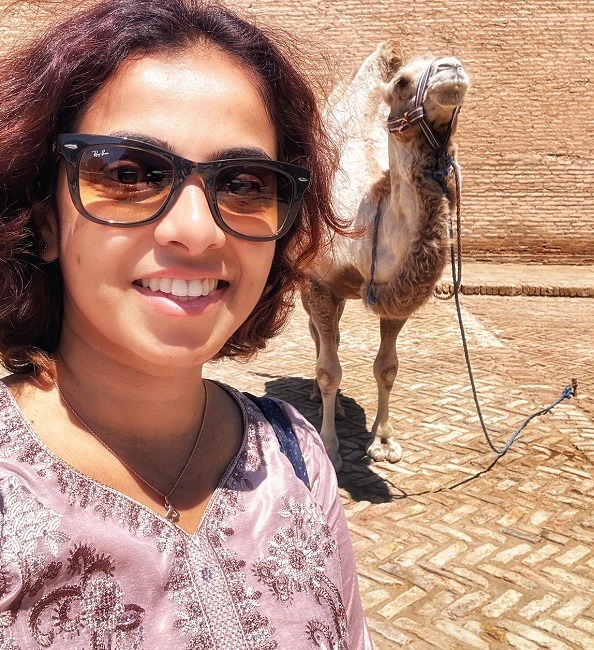
Women must cover their heads with a scarf or shawl when visiting mosques. It’s also respectful to avoid wearing tight or revealing clothing. Men should remove their hats when entering mosques and dress in long pants and shirts with sleeves.
In more urban and tourist areas, dress codes are less strict, but modesty is still advised to respect local customs. While Uzbekistan does not enforce stringent dress codes outside religious sites, respecting cultural norms helps foster positive interactions with locals.
Overall, wearing modest and respectful clothing will ensure a comfortable experience while travelling and visiting various attractions in Uzbekistan.
Highlights of Uzbekistan Travel
Uzbekistan offers travellers a wealth of historical and cultural highlights. It is a country for people who love culture and heritage.
- Samarkand is renowned for its stunning architecture, including Registan Square, surrounded by intricately tiled madrasas. The Bibi-Khanym Mosque and the Gur-e-Amir Mausoleum add to the city’s historical grandeur.
- Bukhara is another gem known for its well-preserved medieval architecture. Key sites include the Ark Fortress, Bolo Haouz Mosque, and the historic trading domes. The city’s old town, with its ancient caravanserais and madrasas, reflects its Silk Road heritage.
- Khiva, a UNESCO World Heritage Site, features the beautifully preserved Itchan Kala, an ancient walled city filled with mosques, minarets, and palaces. Highlights include the Kunya-Ark Fortress and the Juma Mosque.
- Tashkent, the capital, offers a mix of Soviet-era and modern architecture. Key attractions include the Khast Imam Complex, its historic mosques and madrasas, and the bustling Chorsu Bazaar.
- For nature enthusiasts, the Nuratau Mountains and Kyzylkum Desert provide opportunities for trekking and exploring traditional rural life. Uzbekistan’s rich history, vibrant markets, and welcoming hospitality make it a captivating destination for travellers.
Cities and Towns to Visit on Uzbekistan Travel
Tashkent
Tashkent, the capital of Uzbekistan, is a dynamic city that blends Soviet-era and modern influences with rich historical and cultural sites. As a solo female traveller, Tashkent offers a safe and engaging environment with numerous attractions.
What to See:
- Khast Imam Complex: This historical site includes the Barak Khan Madrasah, Tillya Sheikh Mosque, and the Imam Al-Bukhari Islamic Institute. The complex houses the famous Uthman Quran.
- Registan Square: This is the city’s central square, flanked by majestic buildings. It is a great spot to experience the city’s vibrant atmosphere.
- Chorsu Bazaar: A bustling market where local produce, spices, and handicrafts are found. It’s a lively place to experience local culture.
- Tashkent Metro: Known for its ornate stations, it offers a glimpse into Soviet-era design and is a convenient way to travel around the city.
- Amir Timur Square: A central landmark dedicated to the great conqueror Timur, surrounded by impressive statues and fountains.
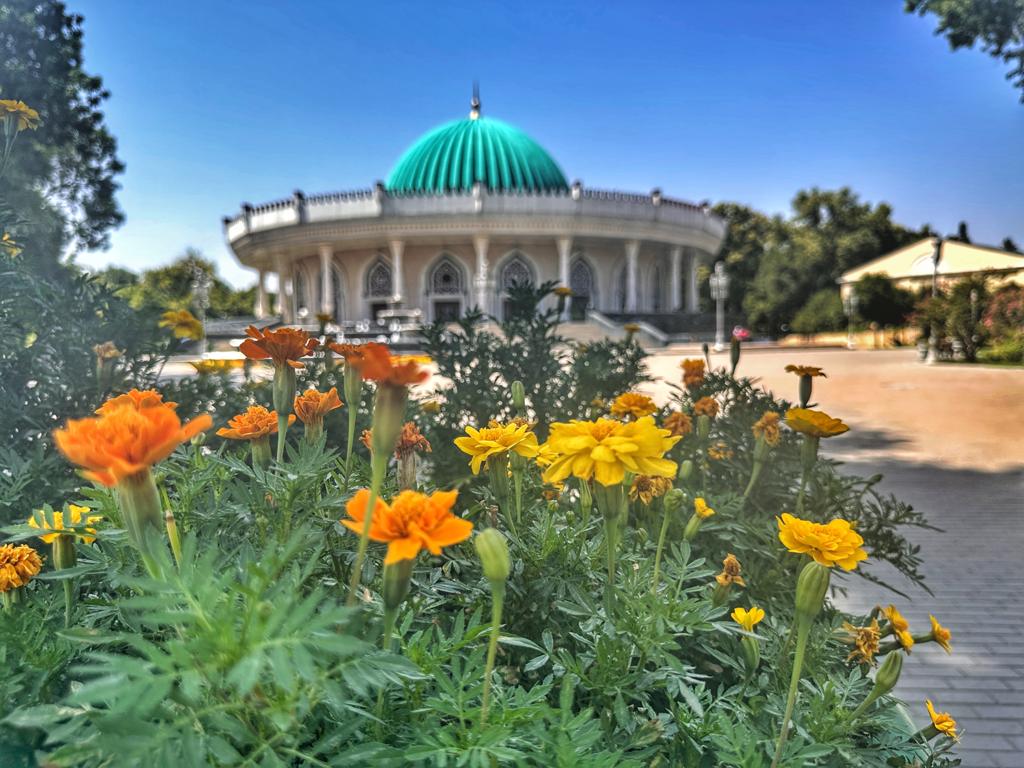
How Many Days: A 2-3 day stay in Tashkent is sufficient to explore these key attractions and experience the city’s unique blend of history and modernity.
Tips for Solo Female Travelers:
- Dress Modestly: While Tashkent is relatively liberal, modest dress shows respect for local customs, particularly in religious sites.
- Use Reputable Transport: For safety, use registered taxis or ride-sharing apps like Yandex Go. The metro is also a safe and convenient option.
- Stay in Well-Reviewed Accommodations: Choose hotels or guesthouses with good reviews and security features.
- Stay Aware: Tashkent is generally safe, but it’s always wise to stay aware of your surroundings and secure your belongings.
Overall, Tashkent offers a rich cultural experience with a blend of historical and modern attractions, making it a rewarding destination for solo travellers.
Khiva
Khiva is a beautifully preserved ancient city in western Uzbekistan known for its stunning architecture and historical significance. It is a UNESCO World Heritage Site and provides a unique glimpse into the Silk Road era.
What to See:
- Itchan Kala: This is the inner, walled part of Khiva, where most of the city’s historical architecture is located. The area is filled with ancient mosques, minarets, and madrasas. Key highlights include:
- Kalta Minor Minaret: Known for its striking blue tiles and unique design.
- Juma Mosque: Famous for its 218 wooden columns, each intricately carved.
- Kunya-Ark Fortress: Once a royal residence, offering panoramic views of the city from its ramparts.
- Pakhlavan Makhmud Mausoleum: This mausoleum, dedicated to a local hero and poet, features beautiful tilework and intricate designs.
- Tash Khauli Palace: The former residence of the Khivan Khan, known for its stunning courtyards and richly decorated interiors.
- City Walls: Walk along the ancient city walls to learn about the historical fortifications and enjoy scenic views of the surrounding area.

How Many Days: A 1-2 day visit to Khiva is generally sufficient to explore the main attractions and experience the city’s unique atmosphere. Itchan Kala’s compact size makes it easy to navigate on foot.
Tips for Solo Female Travelers:
- Dress Modestly: As with other parts of Uzbekistan, modest dress is appreciated. Long skirts or trousers and tops with sleeves are ideal.
- Stay in Safe Accommodations: Opt for well-reviewed hotels or guesthouses with good security. Many accommodations in Khiva cater to tourists and offer a comfortable stay.
- Use Reliable Transport: Yandex Go is unavailable in Khiva, so you must rely on local taxis that your hotel staff can order. Before starting your journey, negotiate the fare with the drivers.
- Stay Aware and Respectful: Khiva is generally safe, but always stay aware of your surroundings and respect local customs and traditions to ensure a positive experience.
Overall, Khiva’s historical charm and well-preserved architecture make it a fascinating destination for solo travellers, offering a glimpse into Uzbekistan’s rich past.
Bhukara
Bukhara is one of Uzbekistan’s most captivating cities, renowned for its well-preserved medieval architecture and historical significance. As a major Silk Road hub, Bukhara offers a wealth of cultural and historical attractions.
What to See:
- Ark Fortress: This massive citadel was the residence of the emirs of Bukhara and provides a fascinating look into the city’s history. Explore its courtyards, museums, and panoramic views of Bukhara from the ramparts.
- Bolo Haouz Mosque: Known for its 208 wooden columns and beautiful façade, this mosque is a serene place to visit. It also features a reflecting pool in front, adding to its charm.
- Registan Ensemble: Although the Registan is more famously associated with Samarkand, Bukhara’s Registan includes several key historical sites, such as the impressive Mir-i-Arab Madrasah.
- Kalon Minaret and Mosque: This iconic minaret is a symbol of Bukhara. The adjoining mosque features beautiful tilework and grand arches. The minaret once called people to prayer and is a stunning architectural marvel.
- Samanid Mausoleum: An early Islamic structure known for its elegant design and intricate brickwork, representing some of Central Asia’s finest early Islamic architecture.
- Trading Domes: The historic trading domes, including Toki Zargaron and Toki Telpak Furushon, offer a glimpse into the city’s commercial past. These covered bazaars are still operational.
How Many Days: A 2-3 day stay is ideal for Bukhara. This allows time to explore the main attractions, experience the local culture, and enjoy the city’s unique atmosphere.
Tips for Solo Female Travelers:
- Dress Modestly: As with other parts of Uzbekistan, modest clothing is recommended. Long skirts or trousers and tops with sleeves are appropriate, especially when visiting religious sites.
- Choose Safe Accommodations: Opt for well-reviewed hotels or guesthouses with good security measures. Many accommodations in Bukhara cater specifically to tourists and offer a comfortable stay.
- Use Trusted Transport Services: Use reputable taxi services like the Yandex Go app or travel agencies to ensure safety and reliability when travelling within the city and to other destinations.
- Stay Aware: Bukhara is generally safe, but it’s always wise to stay aware of your surroundings. Keep your belongings secure and be mindful of local customs and practices.
Bukhara’s rich history and well-preserved architecture make it an intriguing destination for solo travellers. It offers a deep dive into Uzbekistan’s past and culture.
Samarkand
Samarkand is one of Uzbekistan’s most historically significant and visually stunning cities. It is renowned for its rich heritage and is a key Silk Road hub. Its majestic architecture and vibrant history make it a must-visit destination.
What to See:
- Registan Square: This iconic site is the heart of Samarkand, surrounded by three grand madrasas: Ulugh Beg Madrasah, Sher-Dor Madrasah, and Tilla-Kari Madrasah. The complex is renowned for its stunning tilework and architectural splendour.
- Gur-e-Amir Mausoleum: Timur (Tamerlane) ‘s final resting place. This mausoleum is a masterpiece of Islamic architecture, with its striking blue dome and intricate tile designs.
- Shah-i-Zinda: A necropolis with stunningly decorated mausoleums and tombs, Shah-i-Zinda is a revered pilgrimage site offering some of Uzbekistan’s most beautiful tilework. This is one of my favourite places in Uzbekistan.
- Bibi-Khanym Mosque: Once one of the largest mosques in the Islamic world, its grand ruins and the surrounding minarets and domes are a testament to its former magnificence.
- Observatory of Ulugh Beg: Ulugh Beg built this astronomical observatory in the 15th century, offering insights into the era’s advanced scientific achievements.
- Siyob Bazaar: The city’s largest market, where you can experience local life, sample traditional foods, and buy souvenirs.
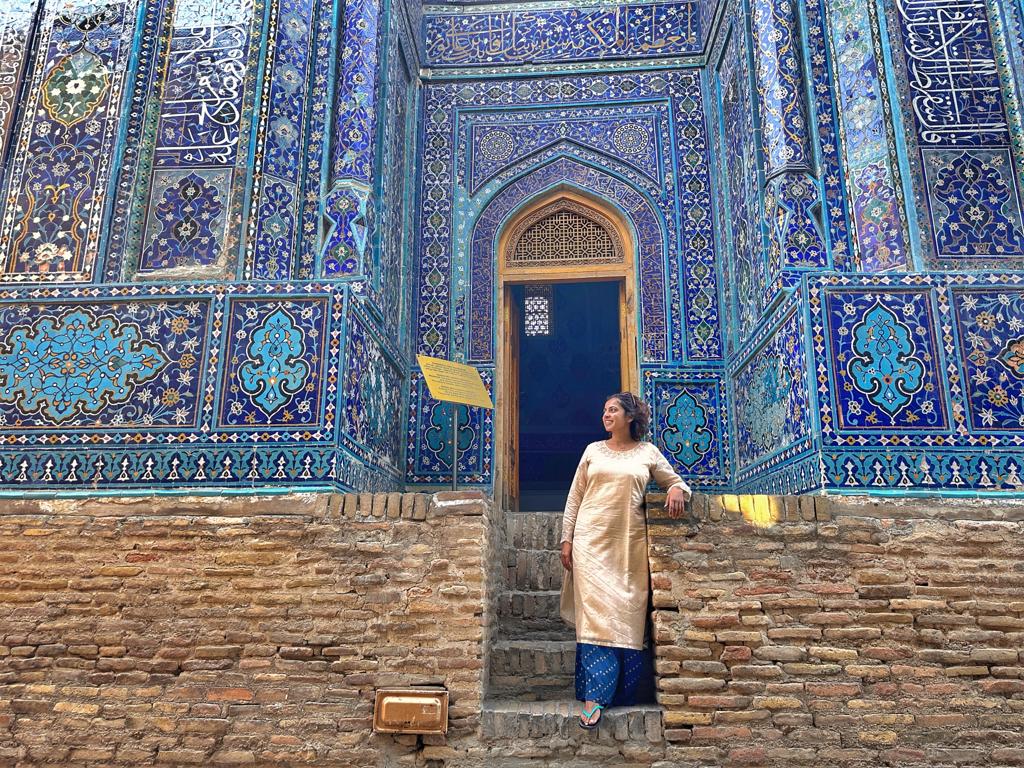
How Many Days: A 2-3 day stay in Samarkand is recommended. This allows ample time to explore the major attractions and soak in the city’s historical and cultural ambience leisurely. If you are short on time, you can also do a one-day trip from Tashkent.
Tips for Solo Female Travelers
- Dress Modestly: While Samarkand is relatively liberal, it’s respectful to dress modestly, especially when visiting religious sites. Long skirts or trousers and tops with sleeves are ideal.
- Opt for Safe Accommodations: Choose well-reviewed hotels or guesthouses with good security. Many establishments cater to international travellers and offer comfortable stays.
- Use Reliable Transportation: Use reputable taxi services or ride-sharing apps like Yandex Go for local travel. The city is relatively safe, but it’s best to use trusted transport options.
- Stay Aware and Respectful: Samarkand is generally safe for solo travellers, but always stay vigilant. Respect local customs and be mindful of your surroundings.
Samarkand’s rich history and architectural wonders make it an unforgettable destination for solo travellers. It offers a deep dive into the grandeur of the Silk Road era.
10 Days Itinerary for Uzbekistan
Here’s a detailed 10-day itinerary for exploring Uzbekistan, covering its major cities, historical sites, and local experiences:
Day 1: Arrival in Tashkent
- Morning: Arrive in Tashkent, Uzbekistan’s capital.
- Check in to your hotel and rest after your flight.
- Afternoon: Explore Tashkent’s landmarks.
- Visit Khast Imam Complex, home to the famous Uthman Quran.
- Walk around Chorsu Bazaar to experience local markets.
- Evening: Stroll through Amir Timur Square and enjoy dinner in the city.
Day 2: Tashkent Sightseeing
- Morning: Visit Independence Square and the Tashkent Metro to see its ornately decorated stations.
- Afternoon: Head to the Museum of Applied Arts and Alisher Navoi Opera and Ballet Theater.
- Evening: Enjoy a local Uzbek dinner at a traditional restaurant.
Day 3: Travel to Khiva
- Morning: Fly or take a train to Urgench and then transfer to Khiva (30 minutes by car).
- Afternoon: Arrive in Khiva and settle into your hotel inside the ancient walled city of Itchan Kala.
- Evening: Take a leisurely evening walk inside Itchan Kala, the UNESCO World Heritage Site.
Day 4: Explore Khiva
- Morning: Full day exploring Itchan Kala.
- Visit the Kalta Minor Minaret, Juma Mosque, Kunya-Ark Fortress, and the Pakhlavan Makhmud Mausoleum.
- Afternoon: See the Tash Khauli Palace and Allakuli Khan Madrasah.
- Evening: Walk along the ancient city walls for sunset views.
Day 5: Travel to Bukhara
- Morning: Travel to Bukhara by train or car (around 7-8 hours by train). Avoid the old Soviet Union trains, as they are uncomfortable.
- Afternoon: Arrive in Bukhara and relax at your accommodation.
- Evening: Take a stroll around Lyab-i-Hauz, a popular area in Bukhara with cafes and a large pool.
Day 6: Explore Bukhara
- Morning: Explore Ark Fortress, the historic seat of Bukhara’s rulers.
- Visit Bolo Haouz Mosque and the Samanid Mausoleum.
- Afternoon: Explore Kalon Minaret and Mosque, Mir-i-Arab Madrasah, and the city’s trading domes.
- Evening: Visit Char Minar, a unique four-towered structure, and enjoy a traditional dinner.
Day 7: Bukhara to Samarkand
- Morning: Take the Afrosiyob high-speed train to Samarkand (around 1.5 hours). Book tickets well in advance, as they sell out quickly.
- Afternoon: Arrive in Samarkand and check in to your hotel.
- Visit Registan Square, Samarkand’s iconic landmark.
- Evening: Relax at a local café near Registan for dinner.
Day 8: Explore Samarkand
- Morning: Visit Shah-i-Zinda, a stunning necropolis with intricately decorated mausoleums.
- Afternoon: Explore the Gur-e-Amir Mausoleum, the resting place of Tamerlane, and Bibi-Khanym Mosque.
- Evening: Visit the Siyob Bazaar for local shopping and snacks.
Day 9: Samarkand to Tashkent
- Morning: Visit the Ulugh Beg Observatory, an impressive astronomical site.
- Afternoon: Take the Afrosiyob train back to Tashkent (around 2 hours).
- Evening: Arrive in Tashkent and enjoy a final evening at a local restaurant.
Day 10: Departure from Tashkent
- Morning: Depending on your flight time, visit any remaining sites or relax before departing to the airport.
Is Uzbekistan Safe for Solo Female Travellers?
Uzbekistan is generally very safe for solo female travellers. The people are friendly, helpful, and welcoming, making it a comfortable destination for those travelling alone. The country has a low crime rate, and locals are always eager to assist tourists, particularly women.
From personal experience, I found the hospitality in Uzbekistan heartwarming. During one of my train journeys, I met a group of local ladies who didn’t speak English, but that didn’t stop them from making me feel welcome. They offered me food and proudly showed me pictures of their grandchildren. Although we didn’t share a common language, their kindness and smiles transcended any barriers. It was an incredible moment of connection, highlighting the warm spirit of the people.
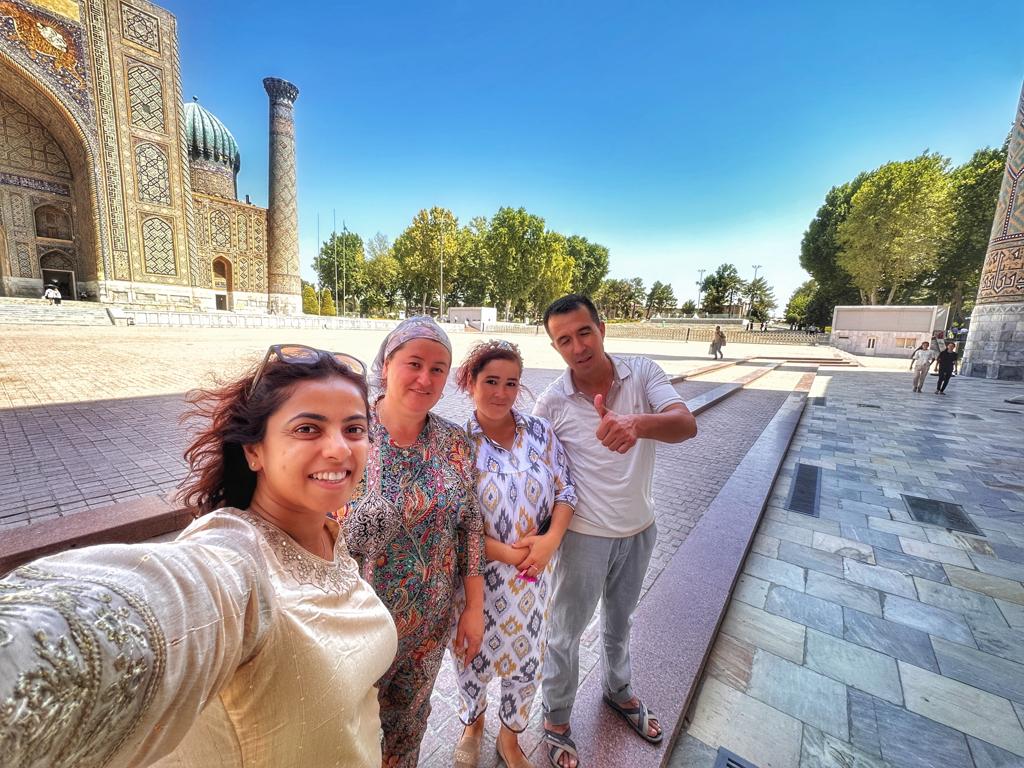
Another unique aspect of travelling in Uzbekistan is the love for Bollywood and Indian culture. Locals, especially in smaller cities, are huge fans of Indian movies and music. As an Indian traveller, I was often approached by people who wanted to take photos with me. Families would ask me to pose with them, and their excitement was genuine. This attention made me feel both safe and appreciated.
For solo female travellers, Uzbekistan’s combination of welcoming locals and cultural fascination makes it a fantastic place to explore. Basic precautions such as dressing modestly and staying aware of your surroundings will help ensure a smooth trip. But overall, you’ll find the country incredibly warm and safe and might experience memorable encounters like mine.
Tips for Solo Female Travelers
- Safety: Uzbekistan is generally safe for solo female travellers. Dress modestly and respect local customs.
- Transport: Avoid old Soviet Union trains; they can be uncomfortable due to broken air conditioning. Book Afrosiyob trains in advance.
- Local Hospitality: Uzbek people are friendly and love Bollywood and Indian culture. You may find locals asking to take photos with you!
Closing Notes
Choosing the best time to visit Uzbekistan depends on the type of experience you are seeking. Spring and autumn remain the most favourable seasons, offering pleasant weather for sightseeing, exploring the bustling bazaars, and visiting the country’s iconic landmarks. These months are perfect for long walks through Samarkand’s Registan Square, Bukhara‘s ancient streets, or Khiva‘s walled city.
While summer is ideal for those who enjoy warmer temperatures and want to experience fewer crowds, it can be extremely hot, especially in desert regions. Conversely, winter offers a quiet and serene experience, though the cold can be intense. It’s an excellent time for those who prefer tranquillity and want to see Uzbekistan covered in snow.
Regardless of the season, Uzbekistan’s rich history, vibrant culture, and stunning architecture make it a rewarding destination year-round. Plan your trip based on your weather preferences, and you can enjoy all the unique beauty and charm this fascinating country offers. Happy travels, and I hope this guide helps you choose the perfect time for your Uzbekistan adventure!
How can you support me?
You know how much I love coffee, so you can buy me a coffee – Buy me Coffee!
Or you can purchase from one of the below travel resources without any extra charge to you:
Travel Resources
Book your flight on Skyscanner.com or Trip.com
Reserve your accommodation on Stay22
Reserve your stay at a hostel on HostelWorld
Use RentalCars or DiscoverCars for hiring self-driven cars
Book your tours and travels or purchase tickets on Viator or GetYourGuide
For a universal SIM card, use DrimSim
Buy comprehensive travel insurance on SafetyWing and WorldNomads
If you liked this article and if it was helpful in your planning or travelling, do share, tweet, or pin this post.
Follow me on Instagram | Facebook | YouTube | Twitter | LinkedIn
Do you have a question? Do you want any suggestions and tips for travel, hikes, and scuba dives? Use the Subscription box below to sign up and get updates by email.
PIN for later reference | Best Time to Visit Uzbekistan: Your Ultimate Travel Guide
